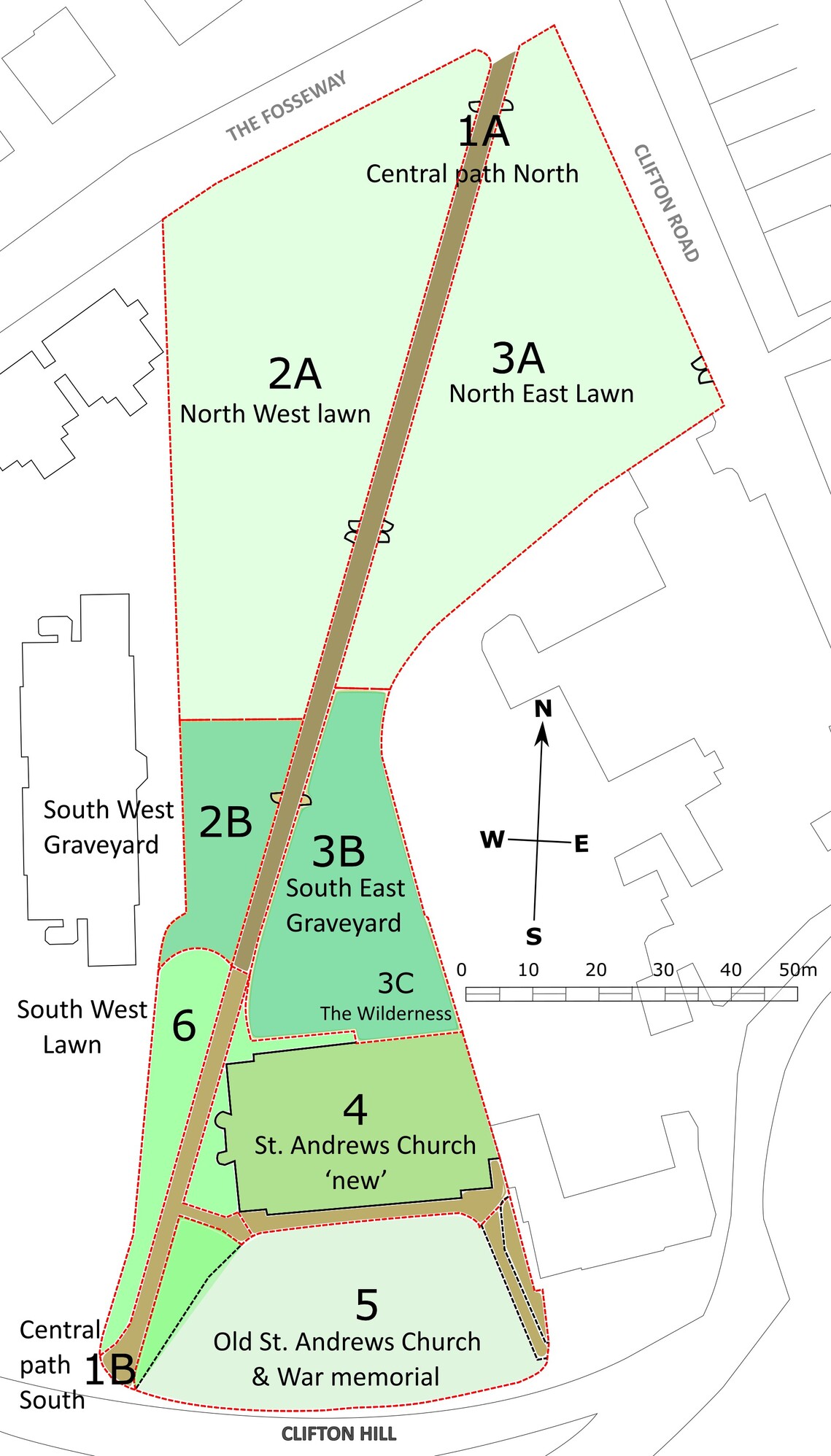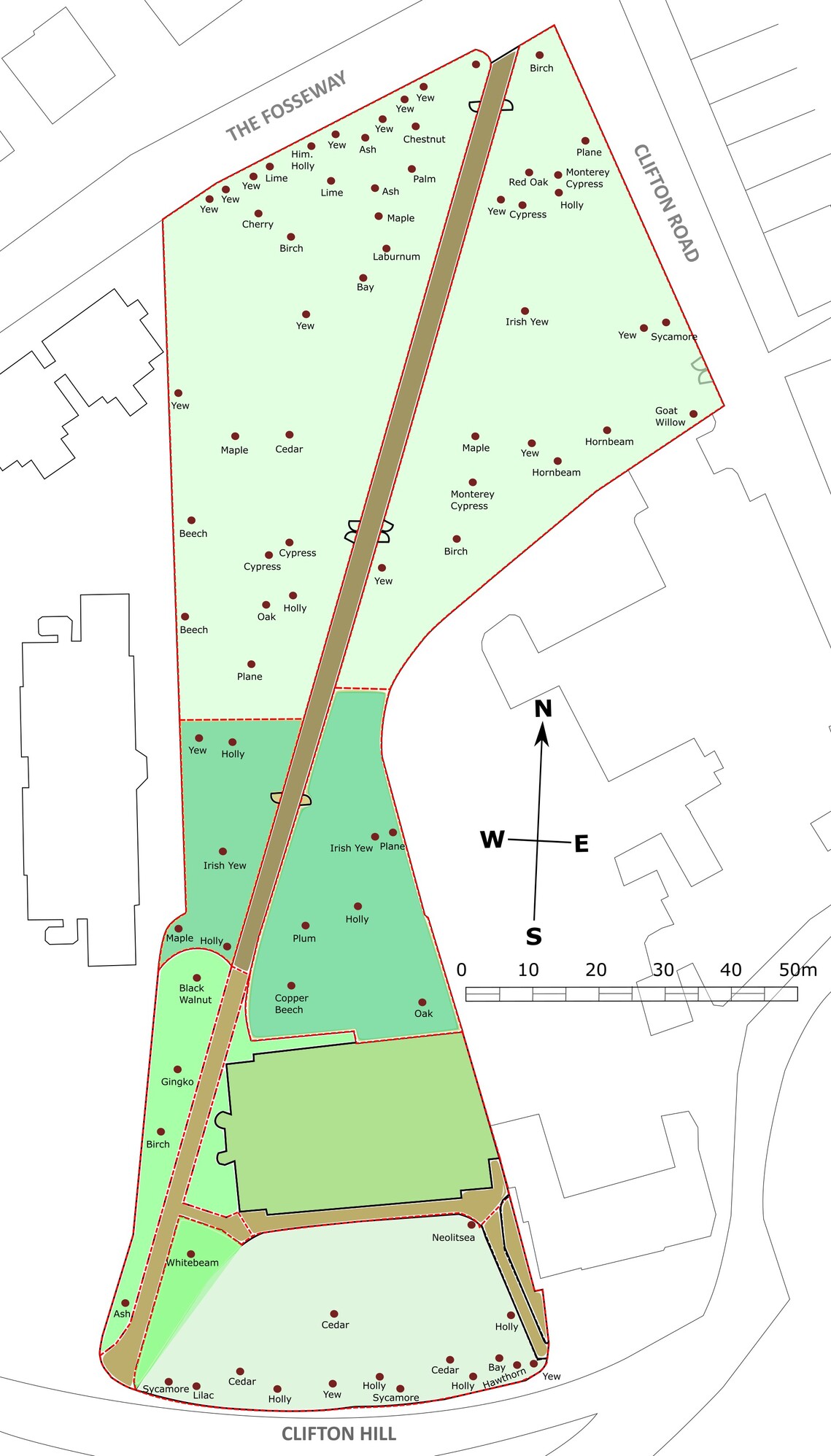Birdcage Walk and St Andrew’s Churchyard
Management and Maintenance Plan 2023 – 2026
Site Details
Location
Birdcage Walk and St Andrew’s Churchyard are located on a 2.7 acre site between The Fosseway (BS8 4EN) and Clifton Hill (BS8 1BN). Grid reference ST573729
Status
The site is the former churchyard of St Andrew’s Church, which was bombed during the Bristol Blitz in November 1940 and the ruins demolished in 1956. Although the churchyard was closed in 1871, some families retained burial rights beyond this date. The churchyard is within the Diocese of Bristol and the Clifton Conservation Area.
Management
Responsibility for the maintenance of the site was passed to the local authority, now Bristol City Council, in 1950. The Parks Department at the Council currently carries out major tree work and cuts the grass in the lawn areas of the site. The Council is also responsible for maintaining the iron hoops and lamps along Birdcage Walk and for repairing the churchyard walls.
Friends of Birdcage Walk and St Andrew’s Churchyard is a group of local volunteers who work with the Parks Department to maintain the site as outlined in the following management plan.
Historical Context
The graveyard on either side of Birdcage Walk was consecrated in 1822 and developed in the second half of the 19th century as a garden cemetery as set out by John Claudius Loudon in his book On the Laying Out, Planting and Managing of Cemeteries (1843). By the early 20th century the lime tree avenue and the many flowering shrubs and trees planted across the site had matured and St Andrew’s was recognised as one of the most beautiful graveyards in the country.
Between 1822 and 1871 Clifton grew from a small village into a fashionable health resort before finally settling into a prosperous suburb. The gravestones and memorials across the churchyard help trace the area’s history since the stories of the dead help build a multi-dimensional picture of 19th century Clifton life.
Today, the churchyard has the potential to become a haven for wildlife. The following plan therefore, seeks to balance environmental requirements with the need to preserve the rich history of the site for future generations.
Aims
- To maintain the churchyard and Birdcage Walk as an attractive, interesting and peaceful space for the local community
- To conserve the graves and monuments as an irreplaceable historical resource
- To create and manage diverse habitats to shelter a wide variety of wildlife
Policies
Graves and Monuments
i. Remove scrub that obscures and damages graves and memorials. Scrub is defined as woody growth including brambles, tree saplings, suckers and low bushes.
ii. Cut back new scrub growth every year and where possible dig out and remove roots to prevent further encroachment.
iii. Remove scrub seedlings and invasive weeds regularly from graves and monuments.
iv. Retain ivy on stonework unless it is: covering plants of interest such as lichens; hiding inscriptions; damaging stonework by growing into cracks and joints. Review ivy regularly to assess whether it should be removed or controlled.
v. Retain and manage designated areas of scrub as wildlife habitat.
Listed Structures
i. All work to the Grade II listed structures is subject to Listed Building Consent or a Certificate of Lawfulness from Bristol City Council.
ii. The Grade II listed structures on Birdcage Walk are as follows: wall, gate piers and gates of the former church of St Andrew, Clifton Hill; walls, piers and railings flanking the footpath; drinking fountain.
iii. No work should be undertaken without the necessary permissions and consent from Bristol City Council.
Wildlife Habitats
i. Create and manage habitats for pollinators by sowing and planting a rich variety of shade tolerant flowers selected to provide a long pollinating season.
ii. Sow and maintain areas of tussocky grass as a source of food and shelter for birds, invertebrates and small mammals.
iii. Build new habitats such as deadwood piles for birds and mammals and a hibernaculum for amphibians and reptiles.
iv. Manage designated areas of scrub to prevent brambles, bushes, bindweed and tree saplings impinging on neighbouring habitats
v. Manage deciduous green waste on site to benefit invertebrates, birds and mammals.
Site Map
Site Map: Key
1 Central Paved Footpath (Birdcage Walk / Lime Tree Walk/ St Andrew’s Walk / Church Walk)
This runs from The Fosseway to Clifton Hill and is divided into two sections:
- Central Path North – green painted railings on both sides starting at The Fosseway
- Central Path South – no railings, ends at the gates to Clifton Hill
2a North West Lawn Graveyard (borders The Fosseway)
Lawned space covering more than 100 graves, exposed graves and memorials, trees and shrubs.
2b South West Graveyard
Densely packed exposed graveyard
3a North East Lawn Graveyard (borders Clifton Road)
Lawned space covering around 200 graves, exposed graves and memorials, trees and shrubs. Brick hut built against the Clifton Road wall. Double wooden gates opening onto Clifton Road.
3b South East Graveyard
Densely packed exposed graveyard.
3c The Wilderness
Area east of the copper beech that is densely packed with graves beneath a thick covering of scrub.
4 New St Andrew’s Church
Open lawned area with benches, east of the unrailed central path. This is the site of the church that was bombed in 1940. The soil is shallow and the ground full of rubble.
5 Old St Andrews Church and War Memorial
East of the unrailed central path on the border of Clifton Hill. The hedges trace the outline of the old church and some of the graves in the surrounding graveyard are still exposed. Trees and scrub grow along the boundary with Clifton Hill.
6 South West Lawned Strip
A narrow lawned strip with benches and trees, west of the unrailed central path. Includes the ‘Rose Garden’ and ‘Semi-Shaded Nectar Bed’.
External Services
- The Friends of St Andrew’s Churchyard and Birdcage Walk do not know the location of the electrical, gas, mains water supply or drainage.
- There is no secure storage on site.
Tree Map
For Further Information:
https://www.caringforgodsacre.org.uk/
https://historicengland.org.uk/advice/caring-for-heritage/cemeteries-and-burial-grounds/
https://www.avonwildlifetrust.org.uk/
https://friendsofbirdcagewalk.org.uk/
Friends of St Andrew’s Churchyard and Birdcage Walk
NC/LW/CM
April 2023
Appendices
A. Seasonal Workplans
B. Waste Management Policy
C. Health & Safety Guidelines
These are subject to annual revision, and the current version of the seasonal workplans can be found here.
Appendix B Waste Management Plan
The current version of the waste management plan can be found here.
i. Every work session will begin with a briefing on the work and there should always be a range of tasks to suit different capabilities. Each volunteer must judge their own fitness to carry out the day’s activities.
ii. Graveyards have many hazards in the form of pot holes, dips and steps, slippery surfaces. Volunteers should wear appropriate clothing, especially sturdy boots with ankle protection.
iii. Volunteers should wear tough gardening gloves, especially if the task involves work on brambles.
iv. Volunteers are advised to lift only what is comfortable and safe. It is recommended that two people carry small dumpy bags.
v. Volunteers will be using their own tools and should keep these tidy so that they are not a trip hazard for the public. Volunteers cannot use power or battery driven tools in the graveyard. Also volunteers must not work from ladders.
vi. Volunteers are covered by Bristol City Council’s Third Party Public Liability Insurance when working in the churchyard.
vii. Volunteers should be aware of the risk of catching toxocariasis from dog faeces.
viii. Volunteers should check that their tetanus vaccination is up to date.
ix. The group leader will have a First Aid Kit and the nearest chemist is Regent Pharmacy, 13 Regent Street.
x. In an emergency, volunteers should call 999.
xi. If a volunteer is involved in an accident on site, the group leader will ask them to fill out an accident report form.
Approved on behalf of Bristol Parks by Operational coordinator Central and East, 19 May 2023.
Website: www.bristol.gov.uk/parks
Report a problem on a street, park or green space in FixMyStreet (bristol.gov.uk)
Alternative links for parks issues Report a problem in a park or open space - bristol.gov.uk; trees Report a problem with a tree - bristol.gov.uk or playgrounds www.bristol.gov.uk/playareaproblem .

